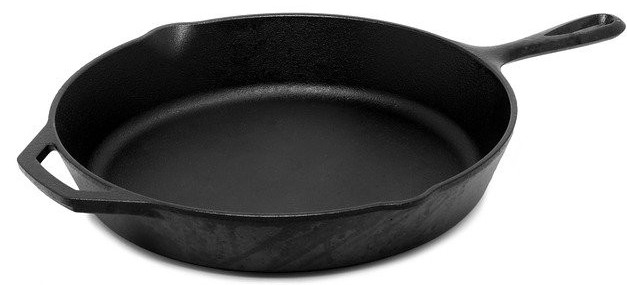
Cast-iron cookware has been around for many years. There are some benefits to using it for certain foods. There are also some drawbacks to it as well. I personally love cooking with cast iron. So let’s dig into the pros and cons of cast iron cookware.
What Is So Special About Cast Iron?
The truth be told, there really is nothing special about cast-iron cookware, except foods taste better when cooked in it. In all actuality, cast iron is old-fashioned, it is heavy, it requires more care and maintenance than modern cookware, and as I already said it is heavy. So, should I avoid cast iron pots and pans? My answer is no. By all means, purchase a cast-iron skillet and fry up some bacon. You’ll quickly see why I like it. I am not a chemist, so I cannot actually tell you why stuff tastes better when cooked in cast-iron, but trust me, it does.
How Difficult is it to Maintain?
Cast-iron is not really difficult to maintain. The main drawback is that you should never wash cast-iron cookware in a dishwasher. Most modern cast-iron pots and pans come pre-seasoned. That means some form of cooking oil has literally been baked into the surface of the cast-iron. If you put it in a dishwasher, with the harsh detergents and high heat, you’ll ruin the seasoning. Then you will have to re-season that pan. That process is time-consuming, will likely smoke up and stink up your kitchen, and is generally kind of a pain in the backside. However, if you wash your cast-iron by hand, using mild dish soap, you likely will not harm the seasoning. Then all you have to do is dry the pan, put it on the stove, and warm it up on medium-low heat to dry up any water that has soaked into the pores of the cast iron. With the pan now fully dry and warm, wipe it down with vegetable oil. Let the warm pan soak in the oil, and once cool, put it away until your next culinary adventure.
How Expensive is Cast-Iron Cookware?
I have to be honest with you here. Cast-iron cookware is a bit more expensive than your standard Walmart or Target brand pots and pans. It is cheaper than some of the professional pots and pans, but it is still not cheap. If I am not mistaken, I paid nearly $40 for a larger cast-iron skillet, but it is worth every penny in my opinion. I think it is a 14-inch diameter skillet. I do need to clarify things a bit though. All of the cast-iron cookware I have bought are Lodge brand. There are several others out there that are cheaper, and a few that are a lot more expensive. I firmly believe you get what you pay for with cast-iron. If you doubt me, go to a Walmart, an Academy Sports and Outdoors, or anywhere cast-iron cookware is sold. Pick up a Lodge skillet, and then pick up one of the cheaper Chinese made cast iron skillets. The Lodge is heavier, looks to be of higher quality, and is made in Tennessee. It’s totally up to you how much you are willing to spend, but you get what you pay for.
Okay, So What is the Advantage of Cast-Iron?
In my opinion, there are many. Now, I am a history buff, and this is going to sound weird to some. I think cooking with cast-iron is kind of an attachment to the “old days”. There is a sense of nostalgia about it. Now, beyond that, think about the durability of your cookware. Non-stick pots and pans are great. If taken care of, they will last for many years. They are easy to maintain…just throw them in the dishwasher. They also heat up much faster than cast-iron. However, they do wear out. The non-stick coating can be easily scratched. They do not tend to hold heat for very long. Cast-iron, if properly taken care of, will likely outlast you, your kids, and probably even their kids. They hold heat well and are very durable. On the other hand, they are heavy, comparatively speaking, and do require a bit more maintenance than non-stick pots and pans. Back to the advantages. Cast-iron does an amazing job of crisping bacon, searing a steak, and is perfect for frying up some catfish or chicken. It can easily be used on the stovetop, in the oven, on a grill, or even over a campfire. Try that with your fancy aluminum non-stick skillet and see what happens. One thing that I should have mentioned though. You cannot just crank your stove up to high heat and throw a cold cast-iron skillet on there. Well, maybe you could, but it is not recommended. Cast-iron should warm up gradually to avoid possibly cracking it. That should be kind of common sense with any metal pan, but especially with cast-iron.
To Wrap This Up…
Cast-iron pots and pans are kind of old-fashioned. They are heavy compared to modern cookware. They do require a bit more care and maintenance than modern cookware. All that being said, they will last a lot longer than modern cookware. Food does taste better when cooked in cast-iron. As I said earlier, you can go from the stovetop to the oven more easily with cast-iron. You can also easily use cast-iron at home, at the campsite, or wherever you like. I personally love it. Is it for the beginner? I think it can be if the beginner is willing to make the effort to properly care for it. If not, stick with the newer stuff. However, I do encourage you to give it a shot. I think you’ll quickly grow to love it. That first pound of bacon you fry up…you’ll see what I mean.
